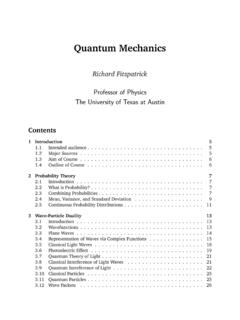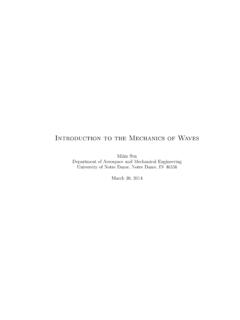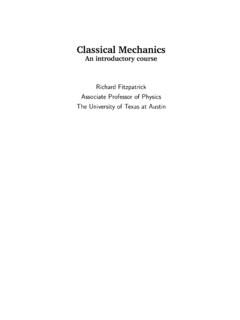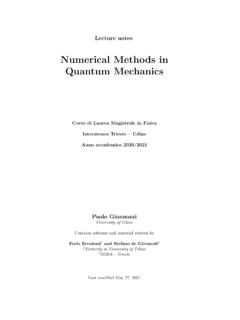Transcription of WAVE EQUATIONS, WAVE FUNCTIONS AND ORBITALS
1 Ravi Divakaran WAVE EQUATIONS, WAVE FUNCTIONS AND ORBITALS . According to the quantum mechanical concept, electrons in atoms and molecules are considered as standing waves ' or stationery waves ' (similar to vibrations in a stretched string, but in 3. dimensions). Properties of a wave Consider a standing wave in a stretched string. As we proceed horizontally along the string, the vertical displacement (or amplitude) of the wave increases in one direction, passes through a maximum, decreases to zero and then increases in the opposite direction. The places where the amplitude is zero are called nodes.
2 The nodes lie on a plane called the nodal plane (which lies perpendicular to the plane of the paper along the x-axis in the above diagram). Upward displacement and downward displacement correspond to opposite phases of the wave. To distinguish between the two phases, one is given a +' sign and the other a sign. If two waves are superimposed exactly out-of-phase (crests of one overlapping with the troughs of the other), they would cancel each other (sum of their amplitudes will become zero). The differential equation which describes the wave is called a wave equation (for an electron, this is the Schr dinger equation).
3 Solution of this equation gives the amplitude ' (phi) as a function, f(x), of the distance x' along the wave. Such a function is called the wave function. Electron waves are described by a wave equation of the same general form as that of string waves . The wave FUNCTIONS that are acceptable solutions to this equation give the amplitude as a function of three coordinates x, y and z necessary to describe motion in three dimensions. These electron wave FUNCTIONS are called ORBITALS . (Any wave equation has a set of solutions actually an infinity of them each corresponding to a different energy level.)
4 The quantum' thus comes naturally out of the mathematics). The electron wave can also have nodes, where the amplitude is zero. On opposite sides of a node, the amplitude has opposite signs, or the wave is of opposite phases. Eg. between the two lobes of a p-orbital lies a nodal plane perpendicular to the axis of the orbital. Therefore the two lobes are of opposite phases. This is often indicated by +' and signs. Note that these symbols do not represent charges. The amplitude or wave function is the orbital. But it is the square of the wave function ( 2) that has physical meaning. For electron waves , 2 represents the probability of finding the electron in any particular place.
5 Irrespective of the sign of , 2 is always positive; this makes sense, since probability cannot be negative. 1. Ravi Divakaran Molecular ORBITALS LCAO method According to molecular orbital theory (MOT), electrons in molecules are in molecular ORBITALS , just as electrons in atoms are in atomic ORBITALS . Electrons in molecules are filled in molecular ORBITALS in accordance with the aufbau' principle, Hund's rule of maximum multiplicity and Pauli's exclusion principle. For simplicity, molecular ORBITALS are considered to be obtained by the combination of atomic ORBITALS of atoms in the molecule.
6 This is analogous to the orbital overlap' concept. For a diatomic molecule AB, the wave FUNCTIONS for molecular ORBITALS are obtained by either adding the wave FUNCTIONS of atomic ORBITALS in A and B, or by subtracting the wave function of one atom from the other, by following certain principles. This is known as the linear combination of atomic ORBITALS (LCAO) method. For molecules having more than two atoms (poly atomic molecules), this process must take into account the atomic ORBITALS of all atoms in them. If ' (psi) represents the molecular orbital of AB, and A and B represents the atomic ORBITALS of A and B respectively, then + = A + B and = A B.
7 When the electron is near atom A, resembles A; when it is near atom B, resembles B. Contribution of atomic orbital from the nearer atom increases while that from the farther atom decreases. For the combination to be effective', ie. for the molecular orbital to be more stable than the separate atomic ORBITALS , A and B must (a) overlap to a considerable extent, (b) be of comparable energy, and (c) must have the same symmetry about the bond axis. Symmetry of ORBITALS (meaning of statement c' above). By symmetry of ORBITALS ', we mean their direction in space, and the phases of the lobes.
8 If the ORBITALS are not directed along the same axis, there cannot be appreciable overlap. For example, see figures: Apart from the direction of approach, the lobes which overlap must have the same sign for effective overlap. waves of opposite signs will destroy each other. Quantum mechanics shows that linear combination of two wave FUNCTIONS (atomic ORBITALS ) gives two combinations of molecular ORBITALS . These are called bonding molecular ORBITALS and antibonding molecular ORBITALS . (In other words, the number of molecular ORBITALS generated is equal to the total number of combining atomic ORBITALS .)
9 Half of these are bonding and the other half antibonding). 2. Ravi Divakaran = A + B (bonding orbital, stabilizes the molecule). * = A B (antibonding molecular orbital, destabilizes the molecule). In the bonding ORBITALS , electrons are concentrated in the region between the atomic nuclei. This lowers the energy of the system. Antibonding ORBITALS have a nodal plane perpendicular to the inter nuclear axis and cutting between the two nuclei. Electrons in antibonding ORBITALS tend to force the atoms apart. The decrease in energy of the bonding orbital is equal to the increase in energy of the antibonding orbital.
10 In addition to bonding and antibonding ORBITALS , there is a third kind called non-bonding ORBITALS . These hold unshared pairs of electrons. They neither increase nor decrease the energy of the system. [For a discussion on simple diatomic molecules, look up any +2 text book]. H ckel molecular orbital theory (HMO theory): Before computers enabled elaborate MO. calculations to be performed routinely, it was necessary to apply greatly simplified approximations to molecules of interest to organic chemists. The most useful of these approximations were those of the H ckel molecular orbital theory for treatment of conjugated systems.







